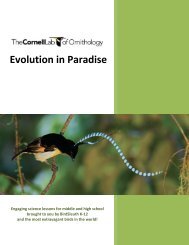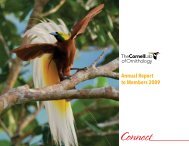National Survey of Fishing, Hunting, and Wildlife ... - All About Birds
National Survey of Fishing, Hunting, and Wildlife ... - All About Birds
National Survey of Fishing, Hunting, and Wildlife ... - All About Birds
Create successful ePaper yourself
Turn your PDF publications into a flip-book with our unique Google optimized e-Paper software.
Large MSA38%Percent <strong>of</strong> Anglers by Residence(Angler population: 33.1 million)Outside MSA11%Small MSA29%Medium MSA21%Metropolitan <strong>and</strong>Nonmetropolitan AnglersWhile residents <strong>of</strong> metropolitan statisticalareas (MSA) 1 had lower participationrates in fishing than non-MSAresidents, they still accounted for themajority <strong>of</strong> anglers. Thirteen percent<strong>of</strong> all MSA residents fished in 2011,but they composed 89 percent <strong>of</strong> allanglers. By comparison, non-MSAresidents composed 11 percent <strong>of</strong> allanglers, but their participation rate wasalmost twice as high at 24 percent.Percent <strong>of</strong> U.S. Population Who Fished by Residence(Total U.S. population that fished: 14 percent)Large MSA(1,000,000 or more)Medium MSA(250,000 to 999,999)Small MSA(50,000 to 249,999)Outside MSA10%15%Percent <strong>of</strong> U.S. Population Who Fished by Household IncomeLess than $20,000$20,000 to $24,999$25,000 to $29,999$30,000 to $34,999$35,000 to $39,999$40,000 to $49,999$50,000 to $74,999$75,000 to $99,999$100,000 to $149,999$150,000 or more11%12%13%13%13%20%24%16%17%19%17%16%Larger MSAs had lower participationrates in fishing than smaller MSAs butcomposed more <strong>of</strong> the angler population.Large MSAs with populations<strong>of</strong> 1,000,000 or more had the lowestparticipation rate at 10 percent, butthey made up 38 percent <strong>of</strong> all anglers.Medium MSAs with a population <strong>of</strong>250,000 to 999,999 had a 15 percentparticipation rate <strong>and</strong> made up 21percent <strong>of</strong> all anglers. Those MSAswith a population from 50,000 to249,999 had a participation rate <strong>of</strong> 20percent <strong>and</strong> composed 29 percent <strong>of</strong> allanglers.Household Income <strong>of</strong> AnglersThe participation rate in fishing tendedto increase as household incomeincreased. The participation rate isthe percent <strong>of</strong> each income group thatfished. The rate <strong>of</strong> those who reportedincomes <strong>of</strong> $75,000 to $99,999 wasthe highest at 19 percent. Those withincomes <strong>of</strong> $50,000 to $74,999 <strong>and</strong>$100,000 to $149,999 had a slightlylower rate <strong>of</strong> 17 percent. Generally, theparticipation rate declined as incomedecreased with exception <strong>of</strong> thosewith incomes <strong>of</strong> $150,000 or morewhich had the same participation rate,16 percent, as those with incomes<strong>of</strong> $40,000 to $49,999. Those withincomes <strong>of</strong> $25,000 to $39,999 had a13 percent participation rate. Thosewith incomes under $20,000 had thelowest participation rate at 11 percent.1See Appendix A for definition <strong>of</strong> metropolitan statisticalarea.16 2011 <strong>National</strong> <strong>Survey</strong> <strong>of</strong> <strong>Fishing</strong>, <strong>Hunting</strong>, <strong>and</strong> <strong>Wildlife</strong>-Associated Recreation U.S. Fish <strong>and</strong> <strong>Wildlife</strong> Service <strong>and</strong> U.S. Census Bureau






